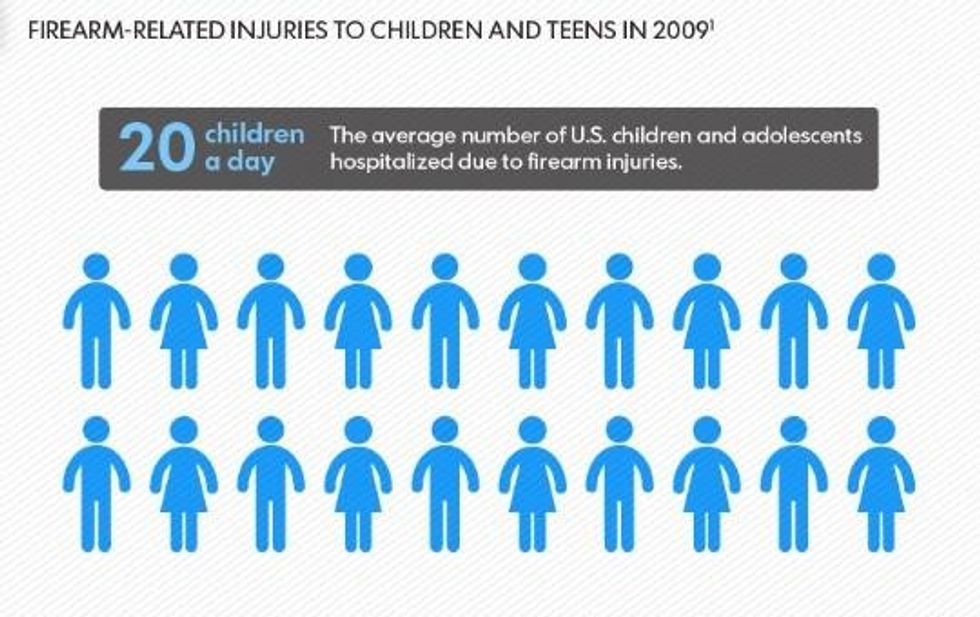

SUBSCRIBE TO OUR FREE NEWSLETTER
Daily news & progressive opinion—funded by the people, not the corporations—delivered straight to your inbox.
5
#000000
#FFFFFF
To donate by check, phone, or other method, see our More Ways to Give page.


Daily news & progressive opinion—funded by the people, not the corporations—delivered straight to your inbox.

The number amounts to almost one child or teen seriously injured by a firearm per hour.
Of the 7,391 hospitalizations analyzed in 2009, six percent resulted in a death, according to the researchers at the Yale School of Medicine which studied the most recent statistics from ER rooms across the U.S.
WebMD reports:
More than half of the gun injuries involved an attack on the child, but nearly one-third were unintentional, the investigators found. (Others were of undetermined causes or from suicide attempts.) Three of four hospitalizations of children younger than 10 resulted from accidental injuries.
"That every day, 20 of our children are hospitalized for firearms injury, often suffering severe and costly injuries, clearly shows that this is a national public health problem," says Robert Sege, director of the Division of Family and Child Advocacy at Boston Medical Center and a co-author of the study.
"The safest home for children and teens is one without guns," said Sege.
USA Today reports:
Researchers analyzed a nationally representative sample of discharge data collected on children and adolescents (up to age 20) in 2009. The data, released in 2011, are the most recent available, Sege says. [...]
The study detailed a significant racial gap: Black children and adolescents comprised 47% of all hospitalizations, 54% of hospitalizations resulting from assaults, 36% from unintentional injuries and 54% from undetermined causes.
______________________
Dear Common Dreams reader, The U.S. is on a fast track to authoritarianism like nothing I've ever seen. Meanwhile, corporate news outlets are utterly capitulating to Trump, twisting their coverage to avoid drawing his ire while lining up to stuff cash in his pockets. That's why I believe that Common Dreams is doing the best and most consequential reporting that we've ever done. Our small but mighty team is a progressive reporting powerhouse, covering the news every day that the corporate media never will. Our mission has always been simple: To inform. To inspire. And to ignite change for the common good. Now here's the key piece that I want all our readers to understand: None of this would be possible without your financial support. That's not just some fundraising cliche. It's the absolute and literal truth. We don't accept corporate advertising and never will. We don't have a paywall because we don't think people should be blocked from critical news based on their ability to pay. Everything we do is funded by the donations of readers like you. Will you donate now to help power the nonprofit, independent reporting of Common Dreams? Thank you for being a vital member of our community. Together, we can keep independent journalism alive when it’s needed most. - Craig Brown, Co-founder |

The number amounts to almost one child or teen seriously injured by a firearm per hour.
Of the 7,391 hospitalizations analyzed in 2009, six percent resulted in a death, according to the researchers at the Yale School of Medicine which studied the most recent statistics from ER rooms across the U.S.
WebMD reports:
More than half of the gun injuries involved an attack on the child, but nearly one-third were unintentional, the investigators found. (Others were of undetermined causes or from suicide attempts.) Three of four hospitalizations of children younger than 10 resulted from accidental injuries.
"That every day, 20 of our children are hospitalized for firearms injury, often suffering severe and costly injuries, clearly shows that this is a national public health problem," says Robert Sege, director of the Division of Family and Child Advocacy at Boston Medical Center and a co-author of the study.
"The safest home for children and teens is one without guns," said Sege.
USA Today reports:
Researchers analyzed a nationally representative sample of discharge data collected on children and adolescents (up to age 20) in 2009. The data, released in 2011, are the most recent available, Sege says. [...]
The study detailed a significant racial gap: Black children and adolescents comprised 47% of all hospitalizations, 54% of hospitalizations resulting from assaults, 36% from unintentional injuries and 54% from undetermined causes.
______________________

The number amounts to almost one child or teen seriously injured by a firearm per hour.
Of the 7,391 hospitalizations analyzed in 2009, six percent resulted in a death, according to the researchers at the Yale School of Medicine which studied the most recent statistics from ER rooms across the U.S.
WebMD reports:
More than half of the gun injuries involved an attack on the child, but nearly one-third were unintentional, the investigators found. (Others were of undetermined causes or from suicide attempts.) Three of four hospitalizations of children younger than 10 resulted from accidental injuries.
"That every day, 20 of our children are hospitalized for firearms injury, often suffering severe and costly injuries, clearly shows that this is a national public health problem," says Robert Sege, director of the Division of Family and Child Advocacy at Boston Medical Center and a co-author of the study.
"The safest home for children and teens is one without guns," said Sege.
USA Today reports:
Researchers analyzed a nationally representative sample of discharge data collected on children and adolescents (up to age 20) in 2009. The data, released in 2011, are the most recent available, Sege says. [...]
The study detailed a significant racial gap: Black children and adolescents comprised 47% of all hospitalizations, 54% of hospitalizations resulting from assaults, 36% from unintentional injuries and 54% from undetermined causes.
______________________